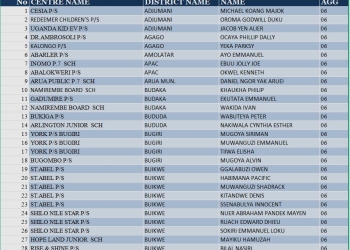 Map of Ngara District, © NordNordWest, CC BY-SA 3.0
Map of Ngara District, © NordNordWest, CC BY-SA 3.0
In the hills of northwestern Tanzania, along the banks of the Kagera River, Ngara District is experiencing a quiet yet profound transformation. While the towering infrastructure of the Regional Rusumo Falls Hydroelectric Project (RRFHP) symbolises regional power generation, its impact extends far beyond the turbines, reaching schools, health centres, water systems, and villages across the district.
Through the Local Area Development Programme (LADP), a benefit-sharing initiative funded by the World Bank as part of the Rusumo Project, local communities have gained much more than just electricity. They now have better access to healthcare, clean water, improved schools, and enhanced livelihood opportunities that are reshaping everyday life.
The LADP, designed to ensure the social and economic benefits of the hydropower project extend to surrounding populations, has invested $5 million in community-prioritised development across the region. With projects focusing on health, education, water, and vocational training, the Rusumo Project is leaving a legacy of inclusion, resilience, and hope for local residents. The initiative is being implemented by the Nile Equatorial Lakes Subsidiary Action Programme (NELSAP).
Education: Investing in the Next Generation

The promise of the Rusumo Project extends beyond infrastructure, it is actively shaping the future of local youth. Through the LADP, several schools and vocational training centres have been built or upgraded, offering children and young adults the chance to learn in improved, well-resourced environments.
Ngara High School, a prominent all-boys’ advanced secondary institution serving approximately 750 students, stands as a testament to this transformation. Once the site of a refugee camp during the Rwandan and Burundian genocides, it has since evolved into a centre for education and renewal.
Previously challenged by overcrowded dormitories, insufficient classroom space, and limited facilities, the school has seen the construction of key buildings, including a dormitory, a multipurpose dining hall, and a modern administration block. These developments have significantly enhanced the school environment and boosted student morale.
“We used to have a big problem with infrastructure,” says Constantine Dolia, a Form Six student. “There weren’t enough buildings for all of us. With the new ones, school life has really improved.”
As part of LADP Phase 2, the upgrades have addressed long-standing issues related to space, organisation, and student welfare.
“Before this project, we didn’t have an administration block or a proper dining hall,” said Headmaster Mr Abel Eliabu Mbita. “During the rainy season, students had to eat outside. That has completely changed.”
The new dining hall can accommodate nearly 1,000 students, while the dormitory houses 80. The administration block brings together departments that were previously scattered across temporary structures, improving overall coordination. With 90% of the 1.2 billion Tanzanian shilling budget already disbursed and construction completed, final inspections are now in progress.
“We’re very grateful for the support,” Mr Mbita added. “The changes are already having a positive impact, and we hope to receive continued assistance to meet the remaining needs.”
Asifiwe Gwihangwe, the LADP Coordinator for Tanzania, echoed this sentiment, emphasising the programme’s commitment to community-driven development. “Ngara High School’s progress is a direct result of listening to local needs and working closely with stakeholders to address them. These investments in education are part of our long-term vision for a resilient and empowered community.”
These investments have eased overcrowding and renewed hope among students, parents, and educators. With a stronger educational foundation in place, the future looks increasingly promising for the next generation.
Expanding Impact: Strengthening Community Health

While education builds a better future, access to quality healthcare ensures that communities are healthy enough to take advantage of these opportunities. The LADP has also made crucial investments in healthcare, most notably through the establishment of the Rusumo Health Centre.
In 2018, the decision was made to build the Rusumo Health Centre, costing 1.5 billion Tanzanian shillings. The facility officially began operations in February 2022 and has become a lifeline for local residents.
“Before the centre, many residents, particularly pregnant women, had to travel long distances to reach healthcare facilities,” said Dr. Prisca Temba. “They often moved from village to village, facing serious challenges just to access basic care.”
The centre’s creation has had a significant impact, particularly on maternal and child health. Malaria, a major concern for pregnant women in the area, can now be addressed more quickly.
“We can now respond to these cases much faster and more effectively,” Dr. Temba explained
For local residents, the health centre’s presence has been a game-changer. Anipenda Yiliki, a resident, recently visited for reproductive health advice. “I wasn’t sick, but I had questions about reproductive health,” she said. “It’s great that I can access this kind of service so close to home.”
By improving accessibility and reducing travel times, the centre is helping meet urgent health needs and providing preventive care for residents who otherwise might not have received it.
The Role of Clean Water in Community Development

In addition to improving healthcare and education, providing clean water has been another transformative outcome of the LADP.
Before the development of the Rusumo Health Centre and other infrastructure, residents struggled with accessing clean water. Many families relied on the river for drinking water, which put their health at risk due to contamination. Waterborne diseases were common, especially during the rainy season.
Recognising this challenge, the LADP supported the establishment of a clean water supply system that purifies river water and provides it to the community through 16 large tanks. This system now serves over 1,000 people, ensuring that clean water is accessible to all.
The provision of clean water has had a significant impact on public health, reducing the incidence of waterborne diseases. It has also empowered women and children, who traditionally bore the responsibility of fetching water, giving them more time for education and other essential activities. With clean water now nearby, villagers no longer face the arduous task of travelling long distances to access water.
Furthermore, the water system supports the Rusumo Health Centre’s sanitation and hygiene needs, which are vital for patient care and the prevention of disease.
“The establishment of this water system has been a game-changer,” said LADP Coordinator Asifiwe Gwihangwe. “Families no longer have to risk their health fetching water from unsafe sources. They now have more time to focus on other essential activities, like education and work.”
The clean water initiative has also supported emergency healthcare. For example, expectant mothers, who previously had to travel 40 kilometres for delivery, now have access to critical services just 2 to 5 kilometres away, drastically improving maternal health outcomes. Additionally, with the rise in motorcycle traffic, the centre has been equipped to handle traffic-related injuries, further ensuring the community’s safety.
A Model for Sustainable Development
From schools to health centres and clean water taps, the Local Area Development Programme under the Rusumo Project is turning basic services into vital elements of long-term prosperity. The focus on health, education, and water access has not only improved daily life but has laid the groundwork for sustainable development in the region.
“As we move forward, we hope these efforts can be replicated in other communities facing similar challenges,” said Mr Gwihangwe. “The success we’ve seen here in Rusumo is a testament to what can be achieved through strong partnerships, government support, and donor commitment.”
He also called on development partners to continue supporting such integrated, community-led efforts: “When we began the water supply project, we were addressing an immediate need for clean, safe drinking water. But we also recognised that it would have a broader impact, from improving health outcomes to creating time for people to engage in other important aspects of life.”
As the district continues to benefit from these initiatives, the story of the Rusumo Project becomes a model of how community-driven development, supported by cross-border collaboration, can create lasting change for generations to come.
















